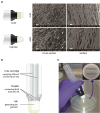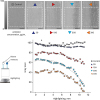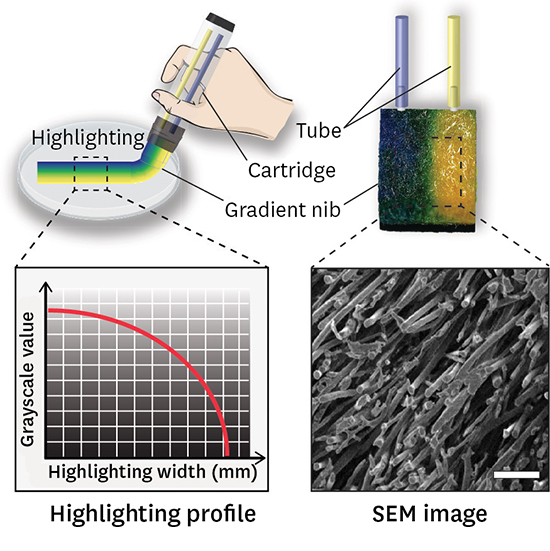1. Bruzewicz DA, Reches M, Whitesides GM. Low-cost printing of poly(dimethylsiloxane) barriers to define microchannels in paper. Anal Chem. 2008; 80(9):3387–3392.

2. Peele JD Jr, Gadsden RH, Crews R. Semi-automated vs. visual reading of urinalysis dipsticks. Clin Chem. 1977; 23(12):2242–2246.

3. Wei YJ, Li KA, Tong SY. The interaction of bromophenol blue with proteins in acidic solution. Talanta. 1996; 43(1):1–10.

4. Quist AP, Oscarsson S. Micropatterned surfaces: techniques and applications in cell biology. Expert Opin Drug Discov. 2010; 5(6):569–581.

5. Martínez E, Lagunas A, Mills CA, Rodríguez-Seguí S, Estévez M, Oberhansl S, et al. Stem cell differentiation by functionalized micro- and nanostructured surfaces. Nanomedicine (Lond). 2009; 4(1):65–82.

6. Abhyankar VV, Beebe DJ. Spatiotemporal micropatterning of cells on arbitrary substrates. Anal Chem. 2007; 79(11):4066–4073.

7. Ginger DS, Zhang H, Mirkin CA. The evolution of dip-pen nanolithography. Angew Chem Int Ed Engl. 2004; 43(1):30–45.

8. Liu GY, Amro NA. Positioning protein molecules on surfaces: a nanoengineering approach to supramolecular chemistry. Proc Natl Acad Sci U S A. 2002; 99(8):5165–5170.

9. Li Y, Maynor BW, Liu J. Electrochemical AFM “dip-pen” nanolithography. J Am Chem Soc. 2001; 123(9):2105–2106.

10. Fang X, Chen H, Jiang X, Kong J. Microfluidic devices constructed by a marker pen on a silica gel plate for multiplex assays. Anal Chem. 2011; 83(9):3596–3599.

11. Rosner B, Duenas T, Banerjee D, Shile R, Amro N, Rendlen J. Functional extensions of dip pen nanolithographyTM: active probes and microfluidic ink delivery. Smart Mater Struct. 2006; 15(1):S124–S130.

12. Banerjee D, Amro NA, Disawal S, Fragala J. Optimizing microfluidic ink delivery for dip pen nanolithography. J Micro Nanolithogr MEMS MOEMS. 2005; 4(2):023014.

13. Rahmanian O, DeVoe DL. Pen microfluidics: rapid desktop manufacturing of sealed thermoplastic microchannels. Lab Chip. 2013; 13(6):1102–1108.

14. Rahmanian O, Chen CF, DeVoe DL. Microscale patterning of thermoplastic polymer surfaces by selective solvent swelling. Langmuir. 2012; 28(35):12923–12929.

15. Srinivasan V, Pamula VK, Fair RB. Droplet-based microfluidic lab-on-a-chip for glucose detection. Anal Chim Acta. 2004; 507(1):145–150.

16. Cooksey GA, Sip CG, Folch A. A multi-purpose microfluidic perfusion system with combinatorial choice of inputs, mixtures, gradient patterns, and flow rates. Lab Chip. 2009; 9(3):417–426.

17. Yoon JH, Jung JW, Moon HS, Shyn KH, Kim KH. Antibiotics susceptibility in bacterial keratitis and proper initial treatment. J Korean Ophthalmol Soc. 2013; 54(1):38–45.

18. Song S, Lee EY, Koh EM, Ha HS, Jeong HJ, Bae IK, et al. Antibiotic resistance mechanisms of Escherichia coli isolates from urinary specimens. Korean J Lab Med. 2009; 29(1):17–24.

19. Jorgensen JH, Turnidge JD. Susceptibility test methods: dilution and disk diffusion methods. Manual of Clinical Microbiology. 11th ed. Washington, D.C.: American Society of Microbiology;2015. p. 1253–1273.
20. Bonev B, Hooper J, Parisot J. Principles of assessing bacterial susceptibility to antibiotics using the agar diffusion method. J Antimicrob Chemother. 2008; 61(6):1295–1301.

21. Biemer JJ. Antimicrobial susceptibility testing by the Kirby-Bauer disc diffusion method. Ann Clin Lab Sci. 1973; 3(2):135–140.
22. Clinical and Laboratory Standards Institute. Performance Standards for Antimicrobial Susceptibility Testing. Twenty-third Informational Supplement M100-S23. Wayne, PA: Clinical and Laboratory Standards Institute;2013.
23. World Health Organization. Model List of Essential Medicines: 18th List. Geneva: World Health Organization;2013.
24. Zamora LL, Mellado RA, Calatayud JM. Quantitative colorimetric analysis of some inorganic salts using digital photography. Anal Lett. 2011; 44(9):1674–1682.

25. Abràmoff MD, Magalhães PJ, Ram SJ. Image processing with ImageJ. Biophoton Int. 2004; 11(7):36–42.
26. Schneider CA, Rasband WS, Eliceiri KW. NIH Image to ImageJ: 25 years of image analysis. Nat Methods. 2012; 9(7):671–675.

27. Collins TJ. ImageJ for microscopy. Biotechniques. 2007; 43(1):Suppl. 25–30.

28. Martinez AW, Phillips ST, Carrilho E, Thomas SW 3rd, Sindi H, Whitesides GM. Simple telemedicine for developing regions: camera phones and paper-based microfluidic devices for real-time, off-site diagnosis. Anal Chem. 2008; 80(10):3699–3707.

29. Cumberbatch T, Hanley QS. Quantitative imaging in the laboratory: fast kinetics and fluorescence quenching. J Chem Educ. 2007; 84(8):1319–1332.

30. Andrews JM. Determination of minimum inhibitory concentrations. J Antimicrob Chemother. 2001; 48:Suppl 1. 5–16.

31. Seo MR, Kim SJ, Kim Y, Kim J, Choi TY, Kang JO, et al. Susceptibility of Escherichia coli from community-acquired urinary tract infection to fosfomycin, nitrofurantoin, and temocillin in Korea. J Korean Med Sci. 2014; 29(8):1178–1181.












 PDF
PDF Citation
Citation Print
Print




 XML Download
XML Download